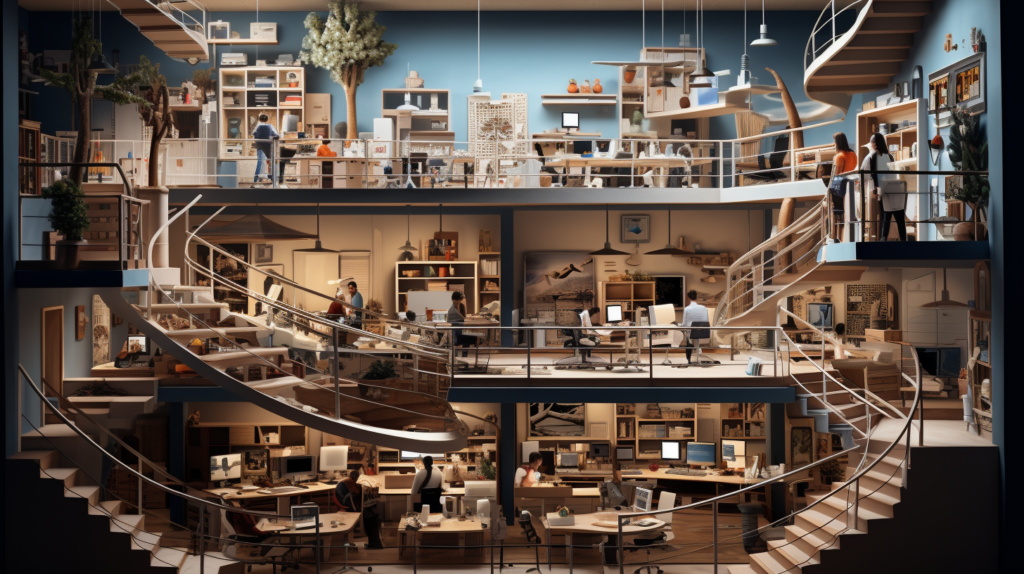When conflicts arise, it can be easy to become overwhelmed and frustrated. After all, why can’t things just go smoothly? But take heart, for there is potential in conflicts to drive creativity as opposed to keeping us stuck in an unproductive cycle. By exploring creative solutions, leveraging conflict into positive outcomes is a possibility. Read on to learn how this can be achieved.
1. Confronting Conflict: A Creative Perspective
Conflict in any form can be a difficult obstacle to navigate, but with the right tools, it can be conquered. Conflict resolution takes creative thinking, understanding, and the willingness to move forward. Here are some creative ways to tackle conflict head-on:
1. Promote Open Dialogue
Open dialogue can be a great way to express your feelings and needs in a conflict. It allows both parties to explain their perspective to come to the best possible outcome. By openly expressing your feelings and needs without finger pointing or blame, you can come to an understanding that satisfies all.
2. Utilize Compromise Strategies
Compromise is a powerful tool for resolving conflicts. Everyone must come to some sort of agreement that both parties are willing to accept. Try to find common ground, be flexible, and look for win-win solutions. It takes creative thinking, but it can make a big difference when it comes to finding the best solution.
3. Take Responsibility for Your Actions
Taking responsibility for your actions is an important aspect of any creative conflict resolution process. Acknowledge your mistakes, apologize, and move forward. This can help to bring closure to the conflict and let both parties move on with clear heads.
Conflict resolution takes creative thinking, understanding, and the willingness to move forward. By promoting open dialogue, utilizing compromise strategies, and taking responsibility for your actions, you can approach conflict with a creative perspective and reach the most equitable outcome.

2. Harnessing Negative Energy: Crafting Creative Solutions
Negative energy can often feel like a downward spiral that robs us of our creativity and optimism. It’s something that can manifest in our lives in ways that are seemingly inevitable and impossible to escape. But by mastering the art of harnessing negative energy, we can still craft creative solutions to the challenges presented in our lives without dampening our enthusiasm and drive.
The first step is to make sure that we don’t allow ourselves to be overwhelmed by the feelings of negativity that accompany a difficult situation. It’s important to remember that these feelings aren’t permanent and that we can still work through them if we are willing to approach them in a constructive way. One great way to do this is to break down big tasks into smaller, more manageable pieces. By creating achievable goals, we can ensure our success and stay focused.
Another key to harnessing negative energy is to recognize our own inner strength and use it to help us unlock our creative potential. Everyone has the power to find creative solutions to problems, and we can use negative energy to open ourselves up to new ideas and approaches. Taking a break to practice mindfulness and relaxation can help us gain a new perspective, clear our minds, and find the clarity we need to think of something new and inspiring.
- Remember that negative feelings are transient and can be worked through
- Break difficult tasks down into small, achievable goals
- Harness negative energy to unlock creative potential
- Mindful practice can give us clarity and a new perspective
3. Compromise & Collaboration: Keys to Positive Outcomes
Compromise and collaboration are key to achieving the best possible outcome in any situation, whether it’s between peers, professional associates, or family members. Understanding how to reach productive resolutions sets the stage for positive interactions on the road ahead. Here are a few tips to help you navigate difficult conversations and find the right path to agreement.
Listen to All Perspectives
Gather all the perspectives in the room and strive to understand the views of each individual. Devote patient attention to comprehending the wants and needs of all parties, even when you don’t personally agree with them. Everyone has a unique viewpoint and a right to voice it, be it valid or not.
Focus on Solutions Instead of Problems
Listing the disagreements will help you identify the issues at hand, but don’t invest too much energy in focusing on the negative. Zero in on solutions and the steps you’ll take to activate it. Brainstorm ideas that please as many beginning points as possible. By working through the various possibilities, you’ll discover something everyone can embrace.
Resolve Conflict with Compassion
Always approach compromise and collaboration with an attitude of understanding and compassion. Speak thoughtfully and slowly, and show empathy instead of hostility or judgment. Even if the answers you provide each other aren’t ideal, your compassion and respect can prevent any further resentment and maintain civil relationships.

4. Understanding Conflict: What Goes Into the Process?
Conflict resolution is an essential skill that requires an understanding of the process behind it. As uncomfortable a situation as it may be, understanding the steps involved in resolving disputes will help create a lasting solution.
At its core, conflict resolution is a communication process. It requires two or more parties to collaborate and share their thoughts and feelings in a structured dialogue. Starting this dialogue is essential for a successful resolution, as it allows each party to express its needs and concerns in an honest environment. It’s also important to take the time to listen and consider what the other party is saying, as the more understanding one has of an issue, the easier it will be to find a solution.
In the communication process, understanding the causes of the conflict is essential. Was it a misunderstanding, a clash of personalities, or something else? Depending on the root cause, the approach for resolving the issue can be tailored accordingly. In some cases, addressing underlying issues and identifying potential triggers of conflict can also be helpful. This allows the participants to be mindful and aware that particular occurrences could cause disagreements to occur again in the future.
5. Analyzing Creative Solutions for Conflict Resolution
No issue in life can be resolved without creative solutions. When it comes to conflicts, the resolution must depend on the individuals or groups involved and the underlying issues that drove them to the situation. Here are five techniques for exploring the potential of creative solutions to disagreements.
- List Potential Ideal Outcomes – The first step in resolving conflict is to brainstorm possible solutions. Make a list of all the ideal outcomes that both parties wish to achieve, as these will ultimately become the basis of the agreement.
- Try Collaborative Problem Solving – This approach encourages both sides to work together to come up with alternative solutions that are mutually beneficial. Through a process of give and take, both parties can look for pragmatic creative solutions to reach a compromise.
- Practice Communication Relating to an Issue – Good communication is the key to any successful conflict resolution. Make sure that everyone involved in the conflict is able to openly communicate and express their feelings and opinions in a respectful manner.
- Get a Neutral Facilitator – If a solution cannot be reached through direct communication, it may be beneficial to bring in an independent third-party to act as a neutral facilitator. This person can help mediate the conversations, help the parties identify potential creative solutions, and provide an objective opinion on the situation.
- Be Open to Creative Solutions – Lastly, it is important to remain open to creative solutions. Sometimes, the most unexpected and creative solutions can be the ones that work best for everyone involved in the conflict.
These are only a few of the many ways to explore the potential of creative solutions to resolving conflicts. With patience, respectful communication, and a bit of creativity, conflicts can be resolved constructively and successfully.

6. Exploiting Conflict Benefits: Encouraging Growth
Conflict is an inevitable part of life, but it need not be a negative experience. In fact, when handled in the right way, conflict can encourage growth and development. Here are 6 tips for how to exploit the benefits of conflict and create a positive outcome:
- Focus on the facts: Resolve the conflict by concentrating on the facts at hand and looking for constructive solutions. Don’t allow emotions to cloud judgment.
- Listen carefully: Pay close attention to what is being said and consider the viewpoint of everyone involved. This will help to reach a positive resolution.
- Encourage debate: Encourage open, honest dialogue and reasoned debate in order to overcome the stalemate. Do not be afraid to challenge accepted norms or to put forward a wide range of ideas.
- Express your ideas: Boldly express your thoughts and feelings without fear of retribution. This will allow the best ideas to surface and create the most constructive and positive outcome.
- Brainstorm solutions: Brainstorm together in order to come up with creative, out-of-the-box solutions. Stay flexible and open to new suggestions in order to find the best solution.
- Celebrate success: It is important to acknowledge the success when it comes. A successful resolution of the conflict can create a sense of unity and accomplishment, which can be a great source of growth for everyone.
When conflict arises, it can be in everyone’s best interest to exploit its benefits by recognizing, understanding and addressing it in a constructive way. By employing these tips, you can turn a potentially destructive situation into an opportunity for growth and development.
7. Unleashing Your Creativity: Using Conflict as a Catalyst
Conflict is an often overlooked part of being creative, yet it can play a very important role in your creative process. When you’re stuck in stagnation, conflict can be a great trigger to open up new ideas and solutions.
Conflicts can arise in the form of internal doubts, doubts about others, or negative feedback. It can also come from having to solve a problem with limited resources, a tight deadline, or tight parameters. Each of these conflicts encourages creative thinking and problem-solving skills, enabling you to think outside the box and come up with more unique solutions.
To unleash your creativity through conflict, consider the following tips:
- Be open-minded. Stay willing to pursue ideas or consider solutions that may seem unorthodox to you.
- Listen. Remember that everyone has a valid point of view and consider how you can use these points of view to build something unique.
- Challenge yourself. Push yourself to come up with solutions or ideas that go beyond what you already know or believe.
- Embrace change. Conflict can lead to change, which is essential in creative endeavors. Don’t be afraid to take risks or to explore uncharted territories.
When used properly, conflict can be a powerful tool to unlock the creative potential within you. Remember to stay open and responsive to the possibilities, and use it as a catalyst for your creative projects and pursuits.
8. The Creative Journey: Turning Conflicting Perspectives into Solutions
Creativity often begins with conflicting perspectives. Whether it’s two people trying to find a common ground, a company considering market options, or a team brainstorming solutions, the process of conflict resolution involves more than a mere toss up game of opposites. To turn opposites into solutions, we must first understand what lies beneath the surface.
It’s essential to consider the “why” and “how” of conflicting perspectives. Step one in turning a conflict of ideas into a collaborative resolution is to shed light on the perspective of those with differing opinions. This helps to uncover motivations, objectives, and potentials for the path ahead. What can be drawn from points of view which may seem unconnected?
Once distinct perspectives have been identified and collaborative potentials seen, the task of turning opposing ideas into solutions can embark. Brainstorming in a group or individually is often an effective method for gathering ideas and muddling out all the details and potential outcomes. Consider the power of ideas in this context –both the ones than seem like a stretch, and more reasonable concepts. An open and honest dialogue between team members lays the groundwork for a creative journey – the journey of turning conflicting perspectives into unified solutions.

9. Creativity in Action: Benefits of Conflict Resolution Techniques
Conflict resolution techniques are essential in fostering peace and collaboration within a workplace or any other environment. While it may seem counterintuitive to seek conflict in order to promote creativity, it is actually quite the opposite. Conflict resolution techniques, when employed correctly, can actually encourage creativity and better problem-solving. Here are just a few of the benefits of using these techniques:
- Improved productivity: Strong communication and problem-solving skills help people progress faster and drive collaboration. Through conflict resolution techniques, people can more easily work together and effectively communicate their ideas, resulting in higher productivity.
- Increase in morale: A team with a higher morale will be more productive, more collaborative and more creative. Conflict resolution techniques help ensure happier employees and better team spirit. This allows for a healthier work environment and improved morale.
- The spark of creative ideas: Collaboration, brainstorming and debate are essential aspects of problem-solving and creativity. Conflict resolution techniques help stimulate and foster these processes, helping to bring out new ideas and uncover creative solutions.
Conflict resolution techniques can be used in any number of situations to foster collaboration, better communication and, ultimately, creativity. By providing employees with the tools to better handle conflicts and problem-solve, you are giving them the opportunity to create and innovate with more confidence. Ultimately, the use of conflict resolution techniques is beneficial for creativity and the growth of any business.
10. When In Doubt: Using Creative Strategies to Expand Your Conflict-Solving Skills
When you’re in the middle of a conflict, it can be difficult to know what to do. The tension can be overwhelming and you may be tempted to just let the situation play out as it will. However, it is important to remember that you can use creative strategies to help you expand your conflict-solving skills and reach a resolution that works for everyone.
These are a few strategies you can try:
- Brainstorm Solutions: Take some time to think of as many creative solutions to the problem as you can. Don’t be afraid to think outside the box and consider alternatives that may be unexpected.
- Change Your Perspective: Ask yourself how other people might view the situation and look for potential win-win situations that work for everyone.
- Practice Positive Communication: Don’t be afraid to express yourself, but also remember to listen and be respectful to the others involved. Good communication can go a long way towards finding a resolution.
Conflict can be difficult to navigate, but with a little creativity and empathy, you can find a middle ground that works for everyone. Remember to be open-minded and try to think of creative solutions, and you’ll be able to successfully resolve the conflict.
We’ve seen that creative solutions can be a powerful force for the leveraging of conflicts into positive outcomes. Challenges shouldn’t be a source of despair, but a call to take action and discover solutions that can make the world a better place. From dialogue to collaboration, we can all take action to drive positive change. So let’s go forth and explore creative solutions – together!
